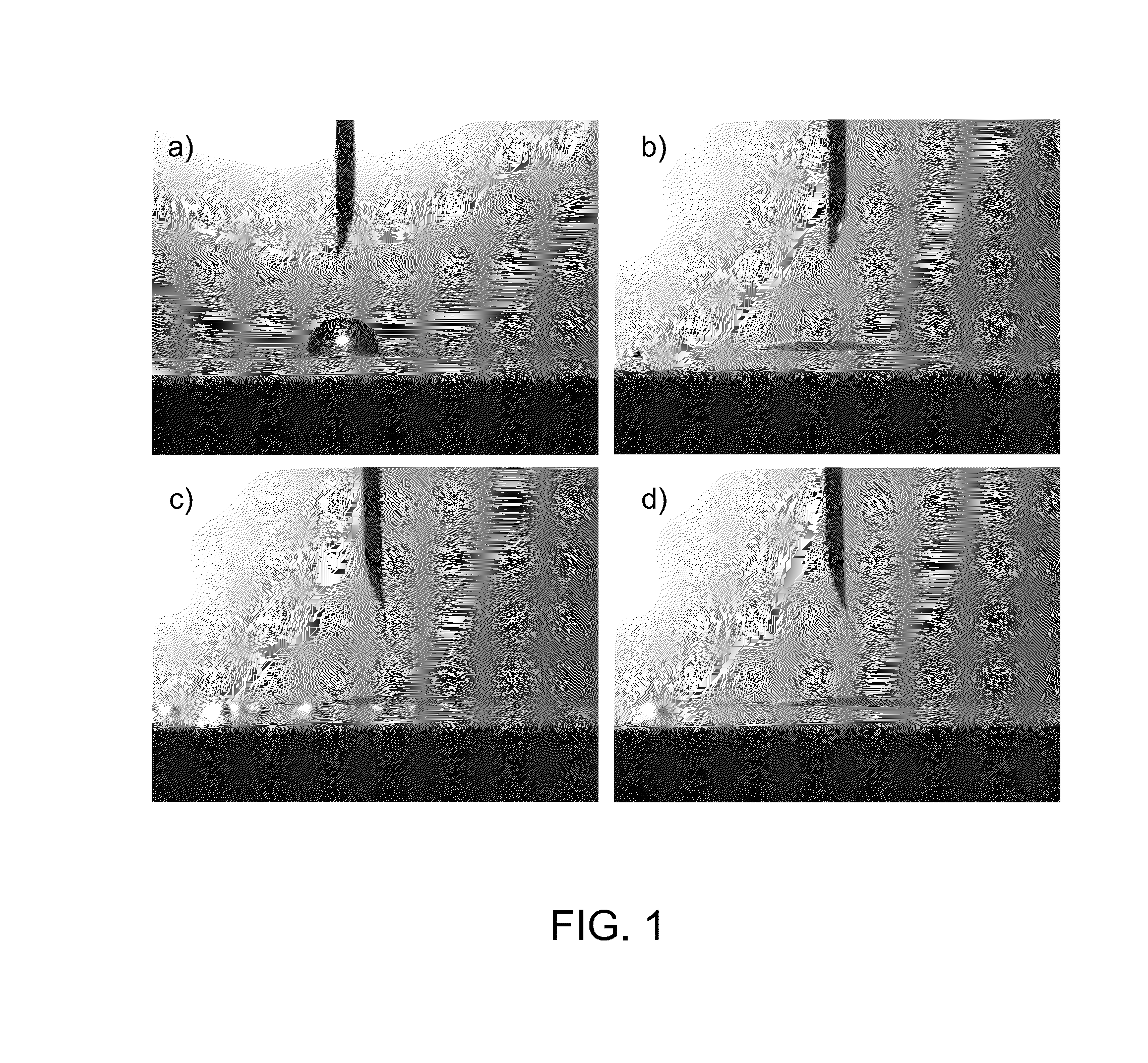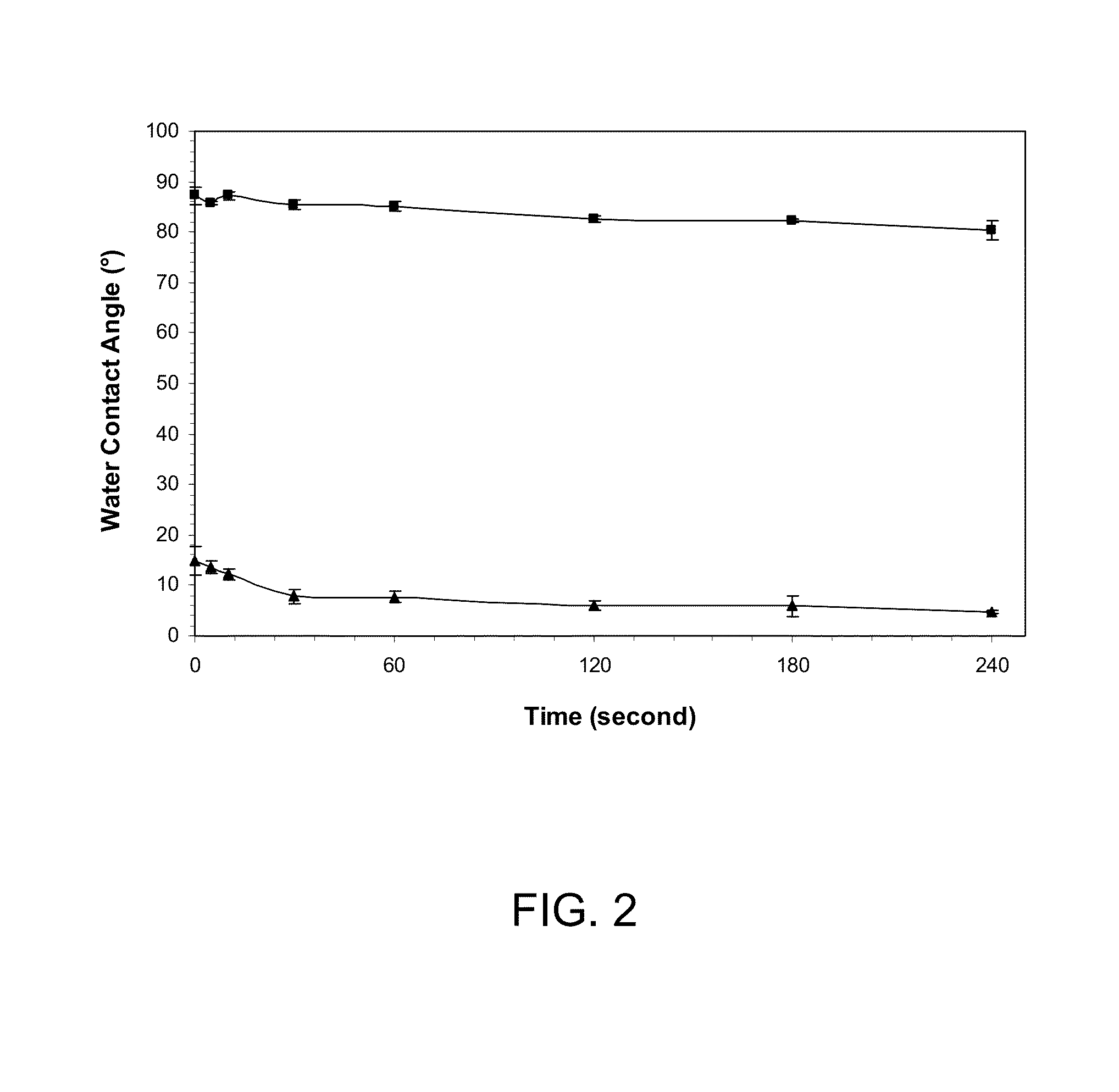Cellulose films with at least one hydrophobic or less hydrophilic surface
a technology of cellulose film and hydrophilic surface, which is applied in the direction of cellulose coating, ceramic shaping apparatus, coating, etc., can solve the problems of high water absorption, high hydrophilicity of cellulose film, and no cellulose film with two different surfaces and yet controllable hydrophobicity
- Summary
- Abstract
- Description
- Claims
- Application Information
AI Technical Summary
Benefits of technology
Problems solved by technology
Method used
Image
Examples
example 1
[0065]20 ml of 0.05% CF suspension was drop-casted, according to General Procedure disclosed above, onto a plastic beaker made of poly(methylpentene) (PMP) to give, after evaporation of the water at ˜20° C., a dry film with a basic weight of 5.0 g / m2.
[0066]FIG. 1a) shows the snapshot (picture) of the water droplet dropped onto the bottom side (surface) of the film. FIG. 1b) shows the picture of the water droplet dropped onto the top side (surface) of the film. The average water contact angle and the standard deviation of the bottom side of the film is 85.4±6.0°. The average water contact angle and the standard deviation of the top side of the film is 14.0±0.8°. The difference in the water contact angles of the bottom and the top sides of the film formed using PMP as the solid support material is 71.4°.
[0067]In a separate experiment, a Glass Petri dish was cleaned with a mixture of 3:1 (v / v) concentrated sulfuric acid and 30% hydrogen peroxide and then thoroughly washed with deionize...
example 2
[0069]10 ml of 0.02% CF suspension was drop-casted, according to General Procedure A disclosed above, onto a PMP plastic beaker to give, after evaporation of the water at ˜20° C., a dry film with a basic weight of 1.0 g / m2. By using a small piece of two-sided tape to cover the film and a wax-paper to cover the tape, and then by pressing the wax-paper-tape-film for a few seconds, the film was peeled off with the bottom side of the film on the top of the tape-wax-paper. The wax-paper was carefully removed and the film-tape was stuck to a glass slide used for the water contact angle measurement. The water contact angle and the standard deviation of the bottom side of the film is 87.2±1.8°.
[0070]The time dependence of the water contact angle on the bottom side of this film, and the time dependence of the water contact angle on the bottom side of the film formed using Glass Petri dish as the solid support and described in Example 1 are shown in FIG. 2. The figure shows that the water con...
example 3
[0071]20 ml of 0.05% CF suspension was drop-casted, according to General Procedure A disclosed above, onto a plastic beaker made of poly(propylene) (PP) to give, after evaporation of the water at ˜20° C., a dry film with a basic weight of 5.0 g / m2. The average water contact angle and the standard deviation of the bottom side of the film is 67.3±11.5°. The average water contact angle and the standard deviation of the top side of the film is 22.8±3.8°. The difference in the water contact angles of the bottom and the top sides of the film formed using PP as the solid support material is 44.5°. PP is capable of inducing the formation of a cellulose film with one less hydrophilic surface and one hydrophilic surface.
PUM
| Property | Measurement | Unit |
|---|---|---|
| water contact angle | aaaaa | aaaaa |
| water contact angle | aaaaa | aaaaa |
| water contact angle | aaaaa | aaaaa |
Abstract
Description
Claims
Application Information
 Login to View More
Login to View More - R&D
- Intellectual Property
- Life Sciences
- Materials
- Tech Scout
- Unparalleled Data Quality
- Higher Quality Content
- 60% Fewer Hallucinations
Browse by: Latest US Patents, China's latest patents, Technical Efficacy Thesaurus, Application Domain, Technology Topic, Popular Technical Reports.
© 2025 PatSnap. All rights reserved.Legal|Privacy policy|Modern Slavery Act Transparency Statement|Sitemap|About US| Contact US: help@patsnap.com


